About
Special News
Logan's Page
Jacoby's Page
Our Travel Index
Tracks Ahead Related Trips
Contact
Argentina - 2007
Originally written for the Tracks Ahead Website.

|
On David's Bucket List, a visit to Patagonia, and the most southern city in the world. |
October 25
We took the shuttle down to O'Hare to begin this journey. And the van driver turned out to be a Tracks Ahead fan, and thus regaled us with tales of segments we should consider. It's nice to see such support for the series. We departed Chicago late, thus putting us into Miami late. And we had a 15 minute run to get to the plane. We made it. Our luggage did not.
October 26
Our US based air carrier,
who shall remain nameless but starts with an "A", is on my "no-fly"
list. What terrible service. The cabin crew was rude, the meals was
horrible (only a forgettable AirTran meal was worse, and that could have
been a tie), there was no movie, and they actually made me pay for a
small bottle of wine. That is a first for international travel. I
asked for a glass of water, and the seated flight attendant did a thumb
over the shoulder and said, "There's a cooler over there."
Oh-kaaay! And to really cap off
 the
experience, my seat was literally in the last row of a 767-300 - right
next to the toilet. Gail was right in front of the toilet, and John was
just ahead and to the side. None of us got very much sleep. Even my
drugs didn't help. We did arrive at 0645, only to find that our luggage
was on the next flight. We hung around the Buenos Aires airport until
1100, got our rain soaked luggage, and cabbed to the hotel. And then
our rooms weren't ready. By the time we got our rooms, the city tour
was starting, and so off we went in the downtown of this metropolis of
12 million
the
experience, my seat was literally in the last row of a 767-300 - right
next to the toilet. Gail was right in front of the toilet, and John was
just ahead and to the side. None of us got very much sleep. Even my
drugs didn't help. We did arrive at 0645, only to find that our luggage
was on the next flight. We hung around the Buenos Aires airport until
1100, got our rain soaked luggage, and cabbed to the hotel. And then
our rooms weren't ready. By the time we got our rooms, the city tour
was starting, and so off we went in the downtown of this metropolis of
12 million people. It was interesting, seeing the National Palace, some renovated
dock areas, and the main train stations. But traffic was heavy, and my
eyes kept slamming shut. The city is pretty, and a mixture of crumbling
old, preserved old, and new. The good news is that my cell phone
works. Yea! It's not cheap, but at least it works. It's amazing that
we did these shoots ten years ago totally out of touch of everyone.
people. It was interesting, seeing the National Palace, some renovated
dock areas, and the main train stations. But traffic was heavy, and my
eyes kept slamming shut. The city is pretty, and a mixture of crumbling
old, preserved old, and new. The good news is that my cell phone
works. Yea! It's not cheap, but at least it works. It's amazing that
we did these shoots ten years ago totally out of touch of everyone.
October 27
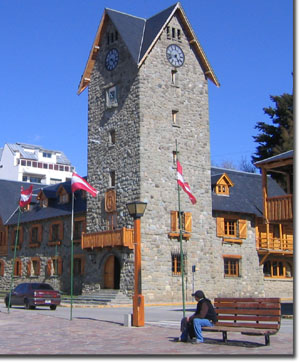 This
mornings wake up call was at 0430. Off we went to the airport for a two
hour flight to the southwestern part of Argentina. The destination was
Bariloche, a town in the foothills of the Andes, and the start of the
Patagonian Region. The town is on the shores of two lakes, and
surrounded by a national park. It is very European looking, having been
originally settled by Chilean Swiss, Austrians, and Germans. So the
architecture is more of a European style. The town has a population of
about 100,000, and is a prime ski spot for the winter months of June
through August. Think of it as the Aspen of Argentina. There is a very
exclusive hotel here, the Llao Llao (pronounced yow, yow) and so
This
mornings wake up call was at 0430. Off we went to the airport for a two
hour flight to the southwestern part of Argentina. The destination was
Bariloche, a town in the foothills of the Andes, and the start of the
Patagonian Region. The town is on the shores of two lakes, and
surrounded by a national park. It is very European looking, having been
originally settled by Chilean Swiss, Austrians, and Germans. So the
architecture is more of a European style. The town has a population of
about 100,000, and is a prime ski spot for the winter months of June
through August. Think of it as the Aspen of Argentina. There is a very
exclusive hotel here, the Llao Llao (pronounced yow, yow) and so we shot some of that, the lakes and a bit of the town. Everyone is
tired. Restaurants don't even start to serve here until 9 PM, so after
a sandwich in the bar, it was off to bed. Tomorrow we start the steam
trains - in particular, the one that inspired the book, The Old
Patagonian Express. Which is what sparked my interest in this place.
we shot some of that, the lakes and a bit of the town. Everyone is
tired. Restaurants don't even start to serve here until 9 PM, so after
a sandwich in the bar, it was off to bed. Tomorrow we start the steam
trains - in particular, the one that inspired the book, The Old
Patagonian Express. Which is what sparked my interest in this place.
October 28
 We
departed Bariloche at a reasonable hour this morning, and boarded the
Tren Patagonico for our trip down to Jacobacci. We did a false start,
which may have been marred by some water blowing on the lens. The line
is the former broad gauge (66 inches) General Roca Railroad. It was
built for tourist purposes and winds through some desolate areas. And
you may have heard that the wind blows in Patagonia. It does, and it is
constant and
We
departed Bariloche at a reasonable hour this morning, and boarded the
Tren Patagonico for our trip down to Jacobacci. We did a false start,
which may have been marred by some water blowing on the lens. The line
is the former broad gauge (66 inches) General Roca Railroad. It was
built for tourist purposes and winds through some desolate areas. And
you may have heard that the wind blows in Patagonia. It does, and it is
constant and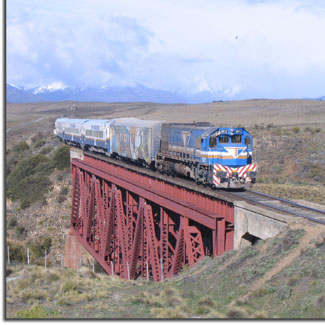 strong. It's strong enough to practically blow you over. We did some
run-bys, and had lunch on the train. I, along with others, caught a bit
of a nap. The train had a cinema car, that was showing DVD films. If
you got bored looking at sheep and wind-swept high desert, you could go
watch a movie. The scenery is rugged, and is high desert. So it is
windy and arid, with few trees. There were remnants of former cars
along the line, and you would see houses built with what looked like
railroad ties. The ranches here are huge - thousands of acres, to
support sheep, cattle, and horses. We pulled into the railroad town of
Jacobacci mid afternoon. The place a little like a wind-blasted west
Texas town, perhaps right out of The Last Picture Show. We did a
strong. It's strong enough to practically blow you over. We did some
run-bys, and had lunch on the train. I, along with others, caught a bit
of a nap. The train had a cinema car, that was showing DVD films. If
you got bored looking at sheep and wind-swept high desert, you could go
watch a movie. The scenery is rugged, and is high desert. So it is
windy and arid, with few trees. There were remnants of former cars
along the line, and you would see houses built with what looked like
railroad ties. The ranches here are huge - thousands of acres, to
support sheep, cattle, and horses. We pulled into the railroad town of
Jacobacci mid afternoon. The place a little like a wind-blasted west
Texas town, perhaps right out of The Last Picture Show. We did a
 little
shooting around the narrow gauge shops. This railroad is the La
Trochita, which is only 30 inch gauge and has some Henschels, Baldwins,
and nice coaches. The line
little
shooting around the narrow gauge shops. This railroad is the La
Trochita, which is only 30 inch gauge and has some Henschels, Baldwins,
and nice coaches. The line was originally built to haul sheep and wool, but is now primarily a
tourist line. And having had enough of the wind, we called it a day.
As a final note, there are a lot of Ford automobiles here. Ford moved
an entire production line down, and ran it until the 1990;s, with little
change. So there are a lot of Ford Falcons and 70/80's era pickup
trucks.
was originally built to haul sheep and wool, but is now primarily a
tourist line. And having had enough of the wind, we called it a day.
As a final note, there are a lot of Ford automobiles here. Ford moved
an entire production line down, and ran it until the 1990;s, with little
change. So there are a lot of Ford Falcons and 70/80's era pickup
trucks.
October 29
The narrow
gauge line (La Trochita 30") starts in Jacobacci, and was built in the
1920's. It was part of a plan to try to bring settlement and development
into Patagonia. The line was not really completed until the
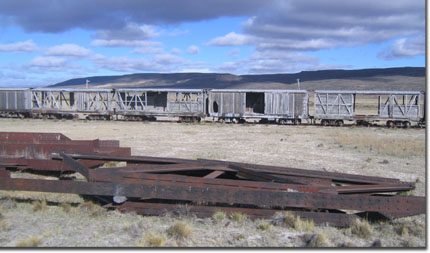 1940's.
There is still plenty of left over material from the construction.
Truthfully, there isn't much here to develop except ranching. The area
is high desert, with an annual rainfall of about 4 inches. It looks a
lot like northern Arizona or parts of Nevada - only a lot more of it.
The vistas are vast and endless. The vegetation is low, clumped, and
windblown. The only sign of human habitation is sheep, wild horses, and
an occasional gaucho (cowboy). There is plenty of desert wildlife. We
saw plenty of Patagonian gulls, hares the size of
1940's.
There is still plenty of left over material from the construction.
Truthfully, there isn't much here to develop except ranching. The area
is high desert, with an annual rainfall of about 4 inches. It looks a
lot like northern Arizona or parts of Nevada - only a lot more of it.
The vistas are vast and endless. The vegetation is low, clumped, and
windblown. The only sign of human habitation is sheep, wild horses, and
an occasional gaucho (cowboy). There is plenty of desert wildlife. We
saw plenty of Patagonian gulls, hares the size of small dogs, and armadillos, as well as lynx, bobcat, wild dogs, and
other desert wildlife. And we saw some flamingos! Through this vast
setting, runs a train. It originally carried a lot of concrete for the
Andean dams, and other construction material. Now it is a tourist line,
headed with Baldwin or Henschel locos, pulling wooden coaches. Our trip
is double headed, and the vastness only accentuates the small size of
the train.
small dogs, and armadillos, as well as lynx, bobcat, wild dogs, and
other desert wildlife. And we saw some flamingos! Through this vast
setting, runs a train. It originally carried a lot of concrete for the
Andean dams, and other construction material. Now it is a tourist line,
headed with Baldwin or Henschel locos, pulling wooden coaches. Our trip
is double headed, and the vastness only accentuates the small size of
the train.
 The
trains make an exciting compliment to the area, with their smoke and
commotion. At every little tow, people stop and wave. We did the usual
photo run-bys, and then we chased the train from the road.
The
trains make an exciting compliment to the area, with their smoke and
commotion. At every little tow, people stop and wave. We did the usual
photo run-bys, and then we chased the train from the road.
As time
was short, we boarded buses for the trip to the hotel. What else
happened today. Let's see - it rained, it snowed, it hailed, and all
this with the Andes in the background. On the way to the hotel, the bus
broke down. 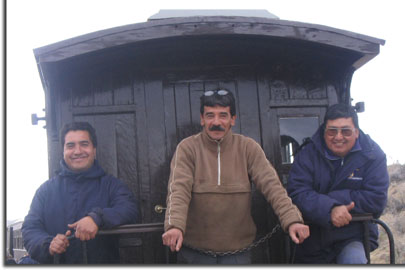 Fortunately, there was an Irish gentleman on the bus who collects
buses. He gave the driver a quick lesson in how to shift without using
the clutch, and though late, we did arrive safely.
Fortunately, there was an Irish gentleman on the bus who collects
buses. He gave the driver a quick lesson in how to shift without using
the clutch, and though late, we did arrive safely.
October 30
 We
left bright and early for the 3 1/2 hour bus ride back over the mountain
to Cerro Mesa to pick up the train. Thankfully, we will have shorter
bus rides as the train gets closer. There were plenty of children
running around and all wanted their pictures taken. We hopped on board,
and spent the day traveling through the vast Patagonia region. We did
the usual photo stops and run-bys, and then had lunch on the train. We
continued to meet
We
left bright and early for the 3 1/2 hour bus ride back over the mountain
to Cerro Mesa to pick up the train. Thankfully, we will have shorter
bus rides as the train gets closer. There were plenty of children
running around and all wanted their pictures taken. We hopped on board,
and spent the day traveling through the vast Patagonia region. We did
the usual photo stops and run-bys, and then had lunch on the train. We
continued to meet interesting people, and grabbed a few sound bites on camera. The
weather started well, but ended with rain. And it ended with an
unfortunate incident where several of the train service cars left the
track at Norquinco. No one was hurt, but some rail was torn up, and the
line interrupted. The La Trochita crew was organized, and - well, these
things happen. There is no fault; just an unhappy occurrence.
interesting people, and grabbed a few sound bites on camera. The
weather started well, but ended with rain. And it ended with an
unfortunate incident where several of the train service cars left the
track at Norquinco. No one was hurt, but some rail was torn up, and the
line interrupted. The La Trochita crew was organized, and - well, these
things happen. There is no fault; just an unhappy occurrence.
October 31
 We
started the day with a bus ride back to El Maiten, but this time over a
mountain road that was still under construction. I think the locals
were surprised to see these large buses on the little one-lane (in
parts) road. But we made it safely, arriving just before Noon. We did
a standup with our guide and explored the shops and salvage yard, As I
mentioned, the line used 50 Henschel and 25 Baldwin locomotives. The
story goes that even though Henschel had won the
We
started the day with a bus ride back to El Maiten, but this time over a
mountain road that was still under construction. I think the locals
were surprised to see these large buses on the little one-lane (in
parts) road. But we made it safely, arriving just before Noon. We did
a standup with our guide and explored the shops and salvage yard, As I
mentioned, the line used 50 Henschel and 25 Baldwin locomotives. The
story goes that even though Henschel had won the bid, their slow delivery prompted the Baldwin infusion. It was sad to
see so many of these little engines just rusting away in the desert. We
did two run-bys, and did a straight run to Leleque. There the train
developed a hotbox on the maintenance car, and we were stuck for a bit,
until the bearing could be cooled and repacked. The rail fans, of
course, loved it. We opted to take the bus on the Esquel, while about
half of the die hard fans rode the train in. -- The train developed a
steam leak, and so was unable to travel very fast. As a result, the
people opting for the train arrived at the hotel about 2 AM. It would
bid, their slow delivery prompted the Baldwin infusion. It was sad to
see so many of these little engines just rusting away in the desert. We
did two run-bys, and did a straight run to Leleque. There the train
developed a hotbox on the maintenance car, and we were stuck for a bit,
until the bearing could be cooled and repacked. The rail fans, of
course, loved it. We opted to take the bus on the Esquel, while about
half of the die hard fans rode the train in. -- The train developed a
steam leak, and so was unable to travel very fast. As a result, the
people opting for the train arrived at the hotel about 2 AM. It would
 have
been a fun experience. One of the passengers described the sunset and
the glow of the engine at night. I'm sorry to have missed it. On the
other hand, we all got to bed early. Other observations: I have never
been to a place where there have been so many bleached bones just laying
around. In the Patagonia area, it is quite common to see carcasses in
various stages of decomposition or just scattered bones. The horses,
cattle and sheep seem to suffer some winter kill or just plain
blundering and dying. Another observation is the wind. It is very,
very windy - the blow you of your feet windy. And it is dusty. All the
wind just drives the dirt into things. We also saw a whole flock of
flamingos. I would not have thought they would be prevalent this far
south, but we have seen quite a few.
have
been a fun experience. One of the passengers described the sunset and
the glow of the engine at night. I'm sorry to have missed it. On the
other hand, we all got to bed early. Other observations: I have never
been to a place where there have been so many bleached bones just laying
around. In the Patagonia area, it is quite common to see carcasses in
various stages of decomposition or just scattered bones. The horses,
cattle and sheep seem to suffer some winter kill or just plain
blundering and dying. Another observation is the wind. It is very,
very windy - the blow you of your feet windy. And it is dusty. All the
wind just drives the dirt into things. We also saw a whole flock of
flamingos. I would not have thought they would be prevalent this far
south, but we have seen quite a few.
November 1
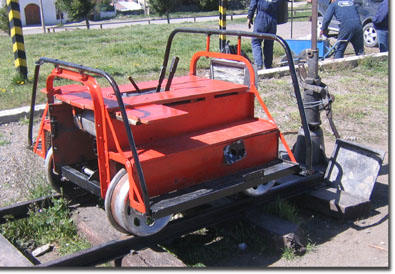 We
had a later start due to the locomotive situation. Just to recap our
journey on La Trochita, the narrow gauge line, we started in Jacobacci,
ran to Norquinco where we had the derailment, on to El Maiten, and
finally ended up at the end of the line in Esquel - a total of around
400 km. At Esquel, they even had a narrow gauge speeder on display. We
started back today, climbing back up to the Patagonian plain, and did a
couple of photo stops. It was a beautiful
We
had a later start due to the locomotive situation. Just to recap our
journey on La Trochita, the narrow gauge line, we started in Jacobacci,
ran to Norquinco where we had the derailment, on to El Maiten, and
finally ended up at the end of the line in Esquel - a total of around
400 km. At Esquel, they even had a narrow gauge speeder on display. We
started back today, climbing back up to the Patagonian plain, and did a
couple of photo stops. It was a beautiful day, with the snow capped mountains sparkling in the distance. The
valley at Esquel was green, and dotted with an occasional spot of a pink
flamingos. And it was really windy, as usual. We stopped at a little
artisan settlement at Nahuel Pan, which looked to be a pretty bleak
existence. And we said adios to our intrepid engine crew who did a
magnificent job on his trip.
day, with the snow capped mountains sparkling in the distance. The
valley at Esquel was green, and dotted with an occasional spot of a pink
flamingos. And it was really windy, as usual. We stopped at a little
artisan settlement at Nahuel Pan, which looked to be a pretty bleak
existence. And we said adios to our intrepid engine crew who did a
magnificent job on his trip.

It is interesting how
satellite communication has opened things up. The remote homes have
Direct TV dishes, and probably an internet connection as well. And cell
service is readily available in the more populated areas. So
integration into civilization continues.
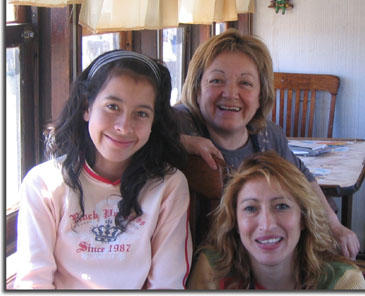
Our wonderful servers on the train posed for a Kodak Moment.
Then it was a 300 km bus ride back to Bariloche. The town was a lot more lively on Thursday night than it was the day before the elections. But for us, it is dinner and bed.
November 2
Our train
today was delayed a bit due to a problem up the line with the regularly
schedule Tren Patagonico. But eventually we boarded the El Historico
Tren a Vapor (Historic Steam Train) for a 38 mile ride from Bariloche to
Perito Moreno. The engine and three restored cars are the
 property
of a preservation society, which gets credit for keeping these things in
operating condition. The engine was a 2-8-0 built in Scotland in 1912.
The cars are all wood, and built about the same time. The dormitory
car, rather misnamed, is very elegant, with a fireplace, kitchen and
sleeping compartments. It is more of a private or business car. We did
a couple of run-bys, arrived at the station, wyed the engine, and headed
back. Was there anything super special? Well, it was neat train, and
property
of a preservation society, which gets credit for keeping these things in
operating condition. The engine was a 2-8-0 built in Scotland in 1912.
The cars are all wood, and built about the same time. The dormitory
car, rather misnamed, is very elegant, with a fireplace, kitchen and
sleeping compartments. It is more of a private or business car. We did
a couple of run-bys, arrived at the station, wyed the engine, and headed
back. Was there anything super special? Well, it was neat train, and the crew was nice, but definitely not used to rail fans who wanted lots
of run-by situations. The food was good, though. What more can I say
about the enjoyable day. For dinner tonight, I hope we aren't headed
for barbeque or steak place. These folks eat late (restaurants don't
open until 8 PM) and they all eat meat - and lots of it. Tomorrow
should be interesting, as our internal air carrier, Aerolineas
Argentina, is on strike.
the crew was nice, but definitely not used to rail fans who wanted lots
of run-by situations. The food was good, though. What more can I say
about the enjoyable day. For dinner tonight, I hope we aren't headed
for barbeque or steak place. These folks eat late (restaurants don't
open until 8 PM) and they all eat meat - and lots of it. Tomorrow
should be interesting, as our internal air carrier, Aerolineas
Argentina, is on strike.
November 3
We generally blew off the morning today and headed out to the airport. Aerolineas was flying and we flew one of their MD-80s south to El Calafate. And the town was quite a surprise to me. This is quite a tourist town, with a great downtown, lots of hotels, and quite a tourist industry. I managed to get some Christmas gifts resolved by power shopping. We are staying at another hotel because our original rooms were damaged in a windstorm. So we are in a five star place down the road. Such is the luck of the draw. As usual, the shorter the stay, the better the hotel. Tomorrow, we start toward Chile.
November 4
I overslept, but only by a
bit. We got on board the buses and departed for Perito Moreno Glacier,
which is a national park just outside of El Calafate. True to the
buildup, the place was pretty impressive, with a nice, blue ice wall.
It actually covers a
 footprint
the size of Buenos Aires, and is one of the fastest moving glaciers in
the world, moving some 30 meters a year. There wasn't as much calving as
the one in Glacier Bay, Alaska, but we did see some. Whether we got it
on tape is another story, as it happens quickly, and without warning.
Just to get a perspective of this thing, the tiny, tiny dot on the water
is a fairly good sized passenger ship. From there, it was off through
endless miles of high desert to the border with Chile, which is where we
are now stuck. Actually, we are still leaving Argentina, as the
officials want to see all the passports, but only ten at a time. So
it's taking a while. And that was just leaving Argentina. Going into
Chile was even more fun. So here we are in a hotel just outside of
Puerto Natales, Chile. I'd like to see the town, but is a 7 km walk.
Maybe tomorrow we can do something.
footprint
the size of Buenos Aires, and is one of the fastest moving glaciers in
the world, moving some 30 meters a year. There wasn't as much calving as
the one in Glacier Bay, Alaska, but we did see some. Whether we got it
on tape is another story, as it happens quickly, and without warning.
Just to get a perspective of this thing, the tiny, tiny dot on the water
is a fairly good sized passenger ship. From there, it was off through
endless miles of high desert to the border with Chile, which is where we
are now stuck. Actually, we are still leaving Argentina, as the
officials want to see all the passports, but only ten at a time. So
it's taking a while. And that was just leaving Argentina. Going into
Chile was even more fun. So here we are in a hotel just outside of
Puerto Natales, Chile. I'd like to see the town, but is a 7 km walk.
Maybe tomorrow we can do something.
November 5
The best description for
today's weather would be "ugly." We had rain, heavy winds and snow throughout most of the day. We had to cross from
Chile to Argentina - about a three hour process - to get to Rio Turbio,
where we were supposed to find a steam tourist train running out of the
coal mine. However, even though the tour group started working on this
over two years ago, the engine was still not ready due to the
intransigence of either the engine owner, the railroad owner or someone
else. The steam engine would have been nice, as it was a little 2-10-2
built by Mitsubishi for the
heavy winds and snow throughout most of the day. We had to cross from
Chile to Argentina - about a three hour process - to get to Rio Turbio,
where we were supposed to find a steam tourist train running out of the
coal mine. However, even though the tour group started working on this
over two years ago, the engine was still not ready due to the
intransigence of either the engine owner, the railroad owner or someone
else. The steam engine would have been nice, as it was a little 2-10-2
built by Mitsubishi for the
 railroad.
But the engine was cold, the railcars were in various stages of rebuild,
and we slopped around in the mud for the morning, shooting the scrap
line, the static engine, and a narrow gauge coal train pulled by a
Romanian diesel. And we braved the cold and rain just to poke around a
bit. Then of course, we headed back to Argentina and another three hour
crossing. The wind continues to blow.
railroad.
But the engine was cold, the railcars were in various stages of rebuild,
and we slopped around in the mud for the morning, shooting the scrap
line, the static engine, and a narrow gauge coal train pulled by a
Romanian diesel. And we braved the cold and rain just to poke around a
bit. Then of course, we headed back to Argentina and another three hour
crossing. The wind continues to blow.

We stopped in Puerto Natales for an instant, as our hotel is out of town, and had good light for a local cathedral. We are supposed to be shuttled into town for dinner possibilities. My laundry is not yet done. The washer-woman will be the richest lady in town by tomorrow.
November 6
 Today
was long but really beautiful. This is the view that greeted me when I
awakened in my rather monastic cell at the hotel. It seemed to bode
well for the day. First, we visited Cuevo del Milodon National
Monument, which is a glacier carved cave. It is so named for some of
the giant sloth remains found in the cave and nearby area. Then it was
on to one of the most beautiful national parks in the world, Torres del
Paines. It is around 263,000
Today
was long but really beautiful. This is the view that greeted me when I
awakened in my rather monastic cell at the hotel. It seemed to bode
well for the day. First, we visited Cuevo del Milodon National
Monument, which is a glacier carved cave. It is so named for some of
the giant sloth remains found in the cave and nearby area. Then it was
on to one of the most beautiful national parks in the world, Torres del
Paines. It is around 263,000 hectacres of unspoiled, undeveloped valleys, lakes, glaciers, and
mountains. Around every turn there is a new sight to be seen. We saw
plenty of guanacos, a small cameloid that looks like a llama, and rheas,
the small ostrich like bird. One thing that helped was the close
proximity to
hectacres of unspoiled, undeveloped valleys, lakes, glaciers, and
mountains. Around every turn there is a new sight to be seen. We saw
plenty of guanacos, a small cameloid that looks like a llama, and rheas,
the small ostrich like bird. One thing that helped was the close
proximity to
 the
coast, so the cloud formations were ever changing hiding peaks,
revealing them, and then making them disappear.
the
coast, so the cloud formations were ever changing hiding peaks,
revealing them, and then making them disappear.
The lake system is
extensive with huge lakes and waterfalls. There are a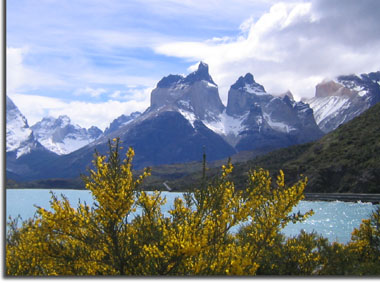 several small hotels and restaurants in the park, and we dined at one of
them, with jagged peaks in the background.
several small hotels and restaurants in the park, and we dined at one of
them, with jagged peaks in the background.
I later have seen articles that this park is one of the places in the world that is highly recommended for a visit.
It was a very pretty day. It was long, but beautiful.
November 7
 Off
we went this morning, in rain and clouds, to the border crossing with
Chile, and then into Argentina. The crossing was supposed to have been
pre-arranged, to cut down our waiting time, but the guy that the tour
guides made the deal with - took the day off. So we still had to wait
for an hour and a half in the snow. But we did get through, and after a
long bus ride, arrived at the steam museum in Rio Gallegos. The place
was more of a scrap yard than a museum, but they do have big plans to
get one of the Mitsubishi's up and running.
Off
we went this morning, in rain and clouds, to the border crossing with
Chile, and then into Argentina. The crossing was supposed to have been
pre-arranged, to cut down our waiting time, but the guy that the tour
guides made the deal with - took the day off. So we still had to wait
for an hour and a half in the snow. But we did get through, and after a
long bus ride, arrived at the steam museum in Rio Gallegos. The place
was more of a scrap yard than a museum, but they do have big plans to
get one of the Mitsubishi's up and running.  Interestingly enough, the Rio Turbio line was originally named for Evita
Peron, but once the military came to power, it was renamed. The coal
loading operations have been scrapped, with rusting shops, an old steam
tug, and shops, in favor of a new, automated facility 30 km south of
town. After killing about 90 minutes there, where we did not shoot
anything, rather to the dismay of the locals, we headed to the airport,
where ominous weather threatens. It
Interestingly enough, the Rio Turbio line was originally named for Evita
Peron, but once the military came to power, it was renamed. The coal
loading operations have been scrapped, with rusting shops, an old steam
tug, and shops, in favor of a new, automated facility 30 km south of
town. After killing about 90 minutes there, where we did not shoot
anything, rather to the dismay of the locals, we headed to the airport,
where ominous weather threatens. It
 could
be an interesting flight. Later. The flight was not bad. It was late,
but smooth and we arrived in Ushuaia around 10 PM. The city is a lot
larger than I had anticipated, and looks quite upscale. At least the
part that we saw from the bus as we were shuttled to our outlying
hotel. So it was a late in. Geographically, it looks a bit like
Skagway, Alaska, with high mountains surrounding the water. It could be
dazzling on a clear day.
could
be an interesting flight. Later. The flight was not bad. It was late,
but smooth and we arrived in Ushuaia around 10 PM. The city is a lot
larger than I had anticipated, and looks quite upscale. At least the
part that we saw from the bus as we were shuttled to our outlying
hotel. So it was a late in. Geographically, it looks a bit like
Skagway, Alaska, with high mountains surrounding the water. It could be
dazzling on a clear day.
November 8
It snowed last night.
There wasn't much accumulation, but it was still snow. With that in
mind, we left for our cruise on the Beagle Channel this morning. It
 was
the usual tourist nature cruise on a catamaran, but we did get to see
sea lions, cormorants, gulls and geese, and an occasional Magellenic
penguin. But it was cold in the brisk wind off the channel. From that
point, we had a few hours downtown, and had lunch in a absolutely
fabulous seafood restaurant. Then, it was off to the El Tren del Fin
del Mundo, The Train at the End of the World. Originally built as a
prison railroad to haul convicts up into the forests, it was been
rebuilt into a tourist line. It is narrow gauge, and had a tank loco,
and two small Garrett type engines pulling
was
the usual tourist nature cruise on a catamaran, but we did get to see
sea lions, cormorants, gulls and geese, and an occasional Magellenic
penguin. But it was cold in the brisk wind off the channel. From that
point, we had a few hours downtown, and had lunch in a absolutely
fabulous seafood restaurant. Then, it was off to the El Tren del Fin
del Mundo, The Train at the End of the World. Originally built as a
prison railroad to haul convicts up into the forests, it was been
rebuilt into a tourist line. It is narrow gauge, and had a tank loco,
and two small Garrett type engines pulling (thankfully!) enclosed cars. Because it turned cold. It snowed, and
then the sun came out, but it was cold. The Garrett type is a compound
loco, with water tenders fore and aft, and the boiler in the middle.
The steam cylinders face towards the center, so that the weight is off
the drivers. That way lighter rail can be used. We first saw these in
Africa, and seeing them here was a bit of a treat. The railroad must be
doing well, as they just ordered two more of them. After the ride, it
was back to the hotel. This was our last day here. Tomorrow we have
multiple flights to get tour next stop - Panama.
(thankfully!) enclosed cars. Because it turned cold. It snowed, and
then the sun came out, but it was cold. The Garrett type is a compound
loco, with water tenders fore and aft, and the boiler in the middle.
The steam cylinders face towards the center, so that the weight is off
the drivers. That way lighter rail can be used. We first saw these in
Africa, and seeing them here was a bit of a treat. The railroad must be
doing well, as they just ordered two more of them. After the ride, it
was back to the hotel. This was our last day here. Tomorrow we have
multiple flights to get tour next stop - Panama.
My only regret on this trip is that Barb did not come along.